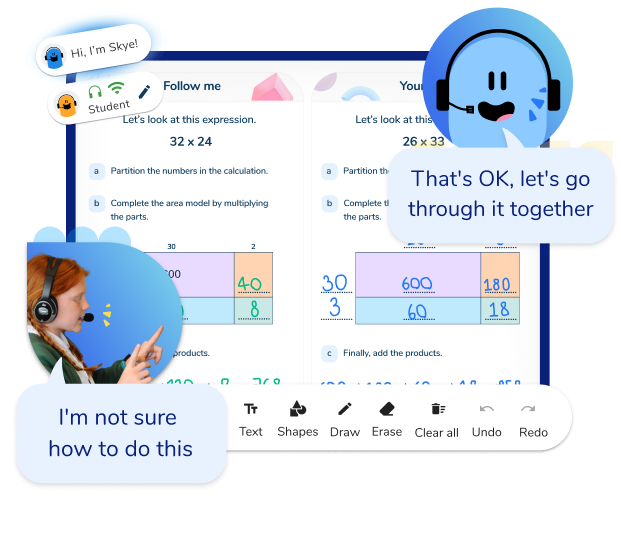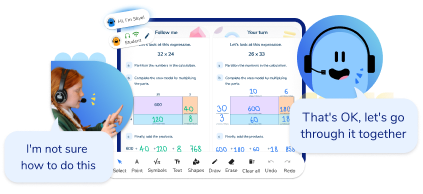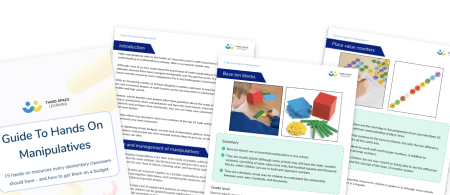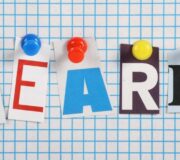Concrete Resources Explained For Parents: How To Use Them With Your Child At Home To Create A Math Master!
If you’re a parent of an elementary school aged child, you are likely to have encountered concrete resources at some point during your child’s math education. Here Emma Johnson, an experienced elementary school math leader explains what they are, and why you should know about them and how to use them.
Mastery math teaching, a math teaching philosophy, is based on the Singapore/Shanghai approach to teaching math, with ‘mastery’ being the ultimate objective for all children.
This method is the concrete representational abstract (CPA) approach, where children are initially introduced to new concepts through the use of concrete resources.
What are concrete resources?
You’ll probably know them as place value counters, base-ten blocks etc. – these are all examples of concrete resources.
Concrete resources (also referred to as manipulatives) are objects or physical resources that children can handle and manipulate to aid their understanding of different math concepts.
A mastery teaching approach to Common Core math or any other math framework encourages children of all ages to keep using these concrete resources, throughout elementary school.
While the abstract nature of math can be confusing for children, through the use of these concrete, practical resources, they are able to ‘see’ the math and make sense of what is actually happening.
Guide To Hands On Manipulatives
A guide to different manipulatives you could use at home and in the classroom. Includes 15 of the best concrete resources from base 10 to tens frames.
Download Free Now!
Using the Concrete-Pictorial-Abstract (CPA) approach
Once children are confident with a concept using concrete resources, they progress to drawing pictorial representations or quick sketches of the objects. By doing this, they are no longer manipulating the physical resources, but are still benefiting from the visual support the resources provide.
Once children have a secure understanding of the concept through the use of concrete resources and visual images, they are then able to move on to the abstract.
Taking division as an example, the formal method is difficult to understand. Although children can be taught the method without understanding the math behind it, this can lead to confusion, errors and difficulties with retaining or remembering the skills or knowledge required to complete division calculations successfully.
If children are taught to use place value counters (concrete) they can make sense of the method.
Once confident with this, they can move on to recording the place value counters pictorially and eventually move on to the abstract formal written method.
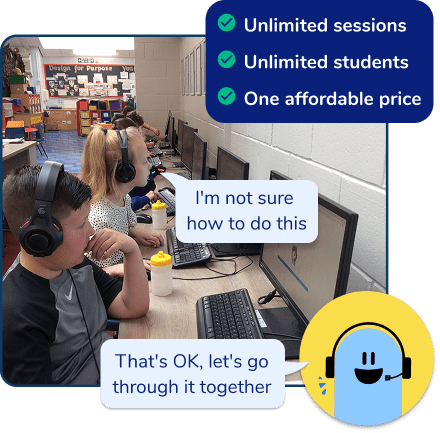
Meet Skye, the voice-based AI tutor making math success possible for every student.
Built by teachers and math experts, Skye uses the same pedagogy, curriculum and lesson structure as our traditional tutoring.
But, with more flexibility and a low cost, schools can scale online math tutoring to support every student who needs it.
Watch Skye in action
Why these teaching aids are a crucial part of mastery teaching
In the past, children were taught procedures, but not why or how the procedure worked. In other words, children learned the methods to get to an answer, without any understanding of the math behind each method or procedure.
Some of you may be thinking, ‘That worked for me, why do children need to understand math now?’
While there are children who are able to access the math concept through just learning a procedure by rote, many others have great difficulty coping with the abstract nature of it.
Teaching methods without meaning leads to misconceptions, errors and difficulties in retaining the methods. Once children can actually ‘see’ the math, they are much more likely to understand and accurately remember the methods.
So, although they should not be exclusive to, concrete resources are particularly important for those children who find math difficult, or lack confidence in math.
How to support your child with math at home using concrete resources
It isn’t just at school that children can benefit from accessing concrete resources in math. They are equally important at home. Lack of resources could be seen as a barrier for supporting your child this way at home, but it doesn’t have to be.
In this blog, I will point you in the direction of the best resources you can buy to teach the key topics, but I will also share ideas for sourcing/creating your own resources at home, to mimic those used in school.
I’ll be looking at some of the key topics in math and identifying the best concrete resources for supporting children (both bought mathematical resources and free alternatives you can access easily at home).
Also, look out in this blog for the videos made with my daughter, Amber, at home showing how the resources help to explain some of the trickier concepts.
Of course there are many topics that you could cover when helping your child with math at home, but we can’t cover them all in one blog. Here are the ones we feel will be the best use of your time!
Place value
The following is information about how you can help your child to learn about place value at home.
School Mathematical resources – Dienes equipment, Numicon and place value counters
Children begin to learn about place value by representing numbers using Unifix cubes and Base-10 blocks.
These are excellent resources for bringing to life the relationship between units, tens and hundreds. Their relative sizes really enable children to visualize the numbers and see the relationship between them.
Once children understand place value using Unifix cubes and Base-10 blocks, they progress to using place value counters. These are used in a similar way, with counters representing ones, tens and hundreds, but with the key difference of all being the same size.
This is useful for bridging the gap from the concrete to abstract nature of place value.
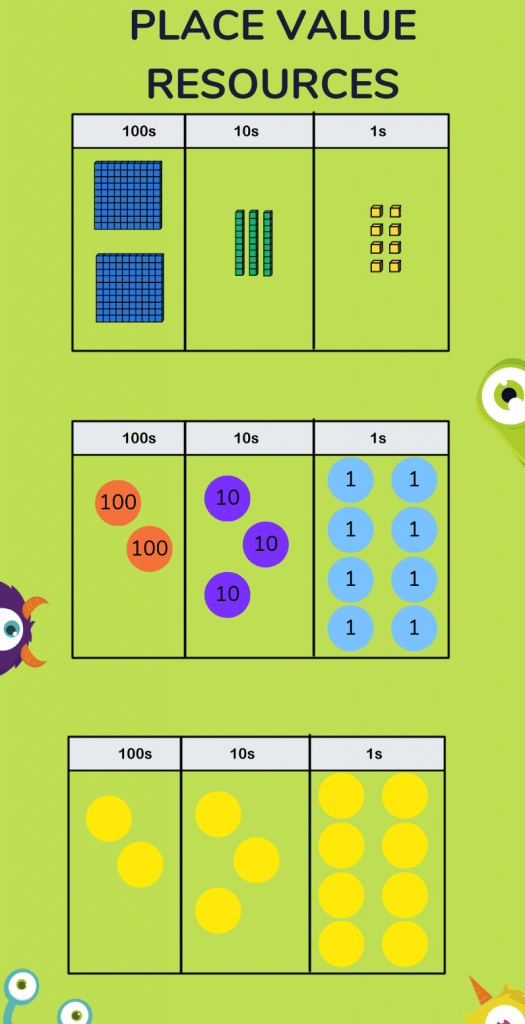
Home alternatives for learning about place value
Straws, popsicle sticks or anything else that can be bundled together are a fantastic alternative to base 10 blocks. For example, individual straws can represent the ones and bundled together into tens to represent the tens.
Lego is another good alternative, using individual bricks for the ones and joining together to make tens. The children are able to visually see the link between the size of the individual straws/bricks and the bundles of ten straws/bricks.
Place value counters can easily be made using plain counters and a marker pen.
Alternatively, you use money, with 1 cent representing the ones, 10 cents the tens and 1 dollar the hundreds.
Written calculation methods
The following is information about how you can help your child to learn about written calculation methods at home.
School Mathematical resources – Base- 10 blocks, Unifix cubes and place value counters
Once children are secure with place value, they are able to use the base-10 blocks and unifix cubes as a first step in understanding the written methods for column addition and subtraction, early multiplication and division.
The equipment is set out in columns on a baseboard as a concrete representation of the formal written method. Children use it to add/subtract the ones first and then the tens. If the calculation requires exchanging, they are able to physically exchange the ten ones for a ten and vice versa.
As with place value, children progress to replacing Base 10 blocks or Unifix cubes with place value counters to solve calculations involving the four operations.
Home alternatives for learning about written calculation methods
As with place value, you can use anything else that can be bundled together as an alternative to base 10 blocks.
Place value counters are easy and cheap to make and coins are another great way for showing hundreds, tens and ones for written calculations.
Fractions
The following is information about how you can help your child to learn about fractions at home.
School resources: Fraction cubes, fraction circles, base-10 blocks, Unifix cubes, counters

Fractions are an area of math children can find particularly difficult, due to their abstract nature. For this reason, it is essential they have practical resources to hold and manipulate or play with.
Fraction cubes or circles are very useful for aiding understanding of the fraction of a whole, add to that using place value counters, Unifix cubes, skittles or smarties and you can demonstrate a real range of fraction concepts: from the basics of what a fraction is; to recognizing equivalent fractions; understanding what happens when a fraction is greater than one and for adding/subtracting fractions.
Finding fractions of amounts is another concept children can have difficulty grasping, particularly when the numerator is greater than one. Using resources, such as cubes or counters – or beans, skittles, smarties or pasta pieces – and physically sharing them out really helps children understand.
Here is a video showing fractions of amounts using the pictorial example of the bar model to explain how it can be used to help children understand.
Home alternatives for learning about fractions
There are lots of cheap/free alternatives to buying fraction resources.
Fraction circles can be made out of paper plates, or downloaded off the internet and printed onto colored paper.
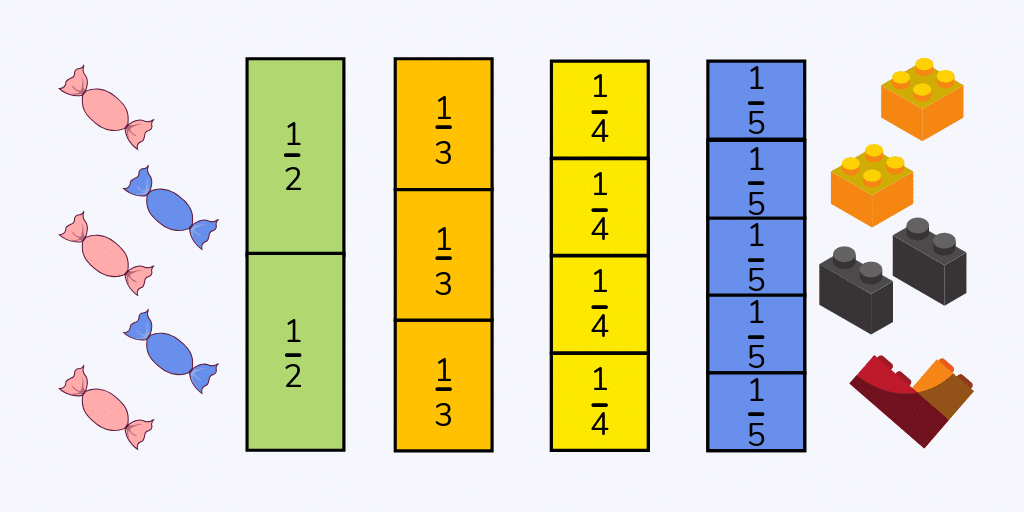
Lego and printable fraction strips are a good alternative to buying fraction cubes.
For fractions of amounts, anything that can be shared out can be used. Food works particularly well for this. For example: raisins, grapes, sweets etc…
Decimals
The following is information about how you can help your child to learn about decimals at home.
School resources: tens frames, hundred squares, decimal place value counters, decimal cubes.
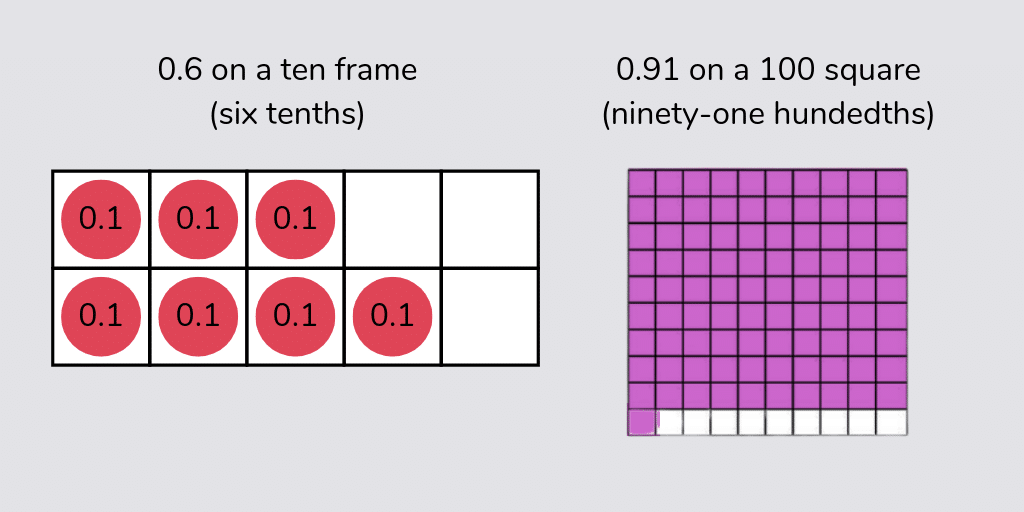
When children are first introduced to decimals, tens frames are useful for helping them to understand tenths, while hundred grids support children with recognizing hundredths.
Tens frames are a particularly useful resource for enabling children to see the link between decimals and fractions, while also helping children to understand concepts such as rounding decimals.
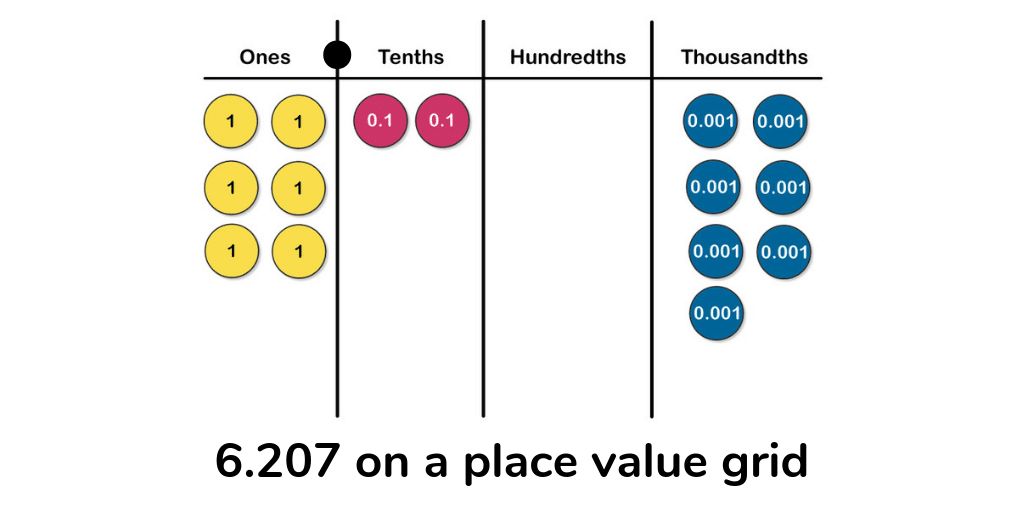
Place value counters positioned on a place value grid are useful for helping children to understand place value of decimal numbers. Children can visually see how many tenths and/or hundredths a number has and they can help them understand how to compare and order decimals.
Home alternatives for learning about decimals at home
All these resources can be found/created at home. Tens frames, hundreds grids and decimal strips can be printed off the internet while decimal place value counters can be made by writing 0.1 on one set of counters and 0.01 on another.
Percentages
The following is information about how you can help your child to learn about percentages at home.
School resources: Hundred grids, percentage cubes
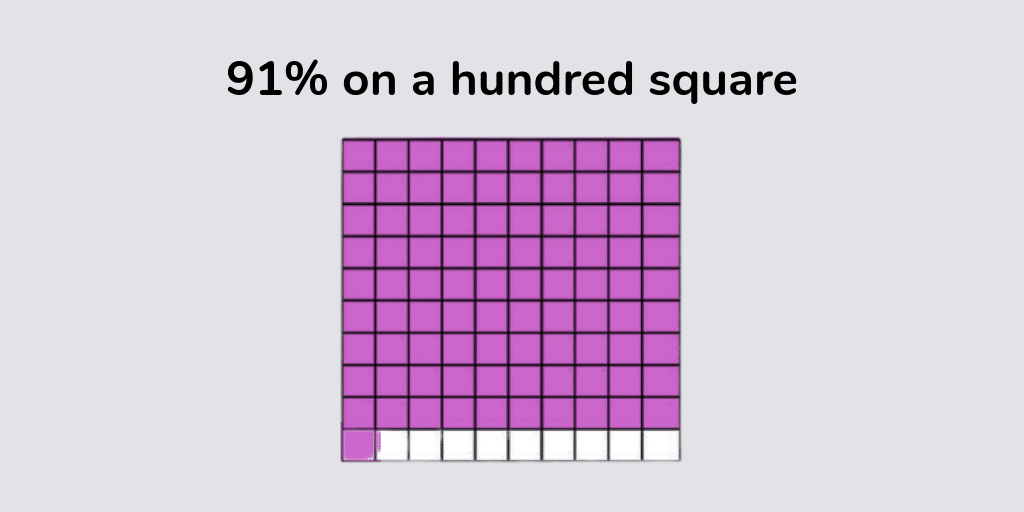
Hundred grids are useful for supporting children’s understanding of the concept of percentage being ‘out of 100’. Hundred grids can be shaded in, or place counters on each square, to represent different percentages.
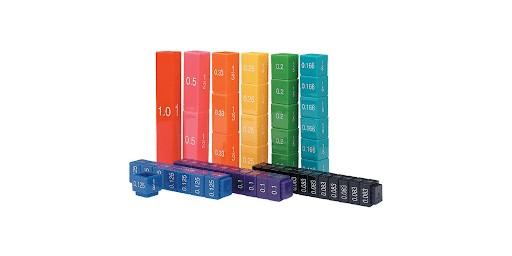
Percentage cubes are also useful in helping children to understand percentages and enable children to see the link between fractions, decimals and percentages.
Home alternatives for learning about percentages at home
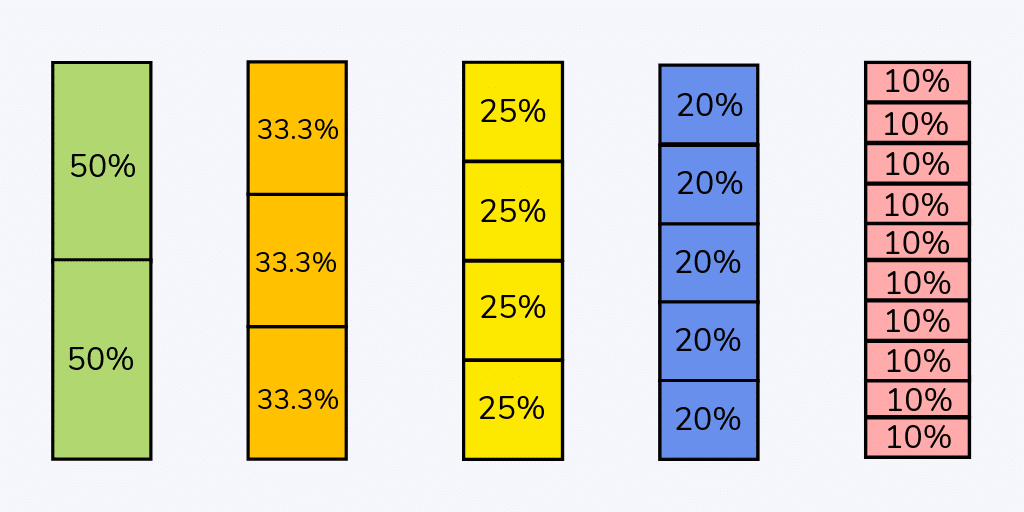
As with decimals, hundred grids and percentage strips can be printed off the internet for free and lego is a great concrete resource for supporting children with percentages.
Telling the time
The following is information about how you can help your child to learn how to tell the time at home.
School resources: Clock faces
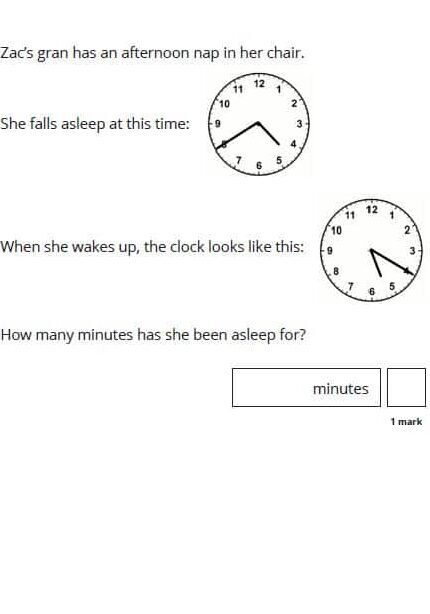
Analogue clocks, which can be manipulated by moving the hours and minutes hand around, help children to grasp the concept of time.
Ideally these clocks will have removable hands, to enable children to look at the hours and minutes hands independently, before looking at both together on the same clock.
Children can struggle to understand the concept of time when presented with both hands together. It is much better to teach children to understand the hours hand by itself,
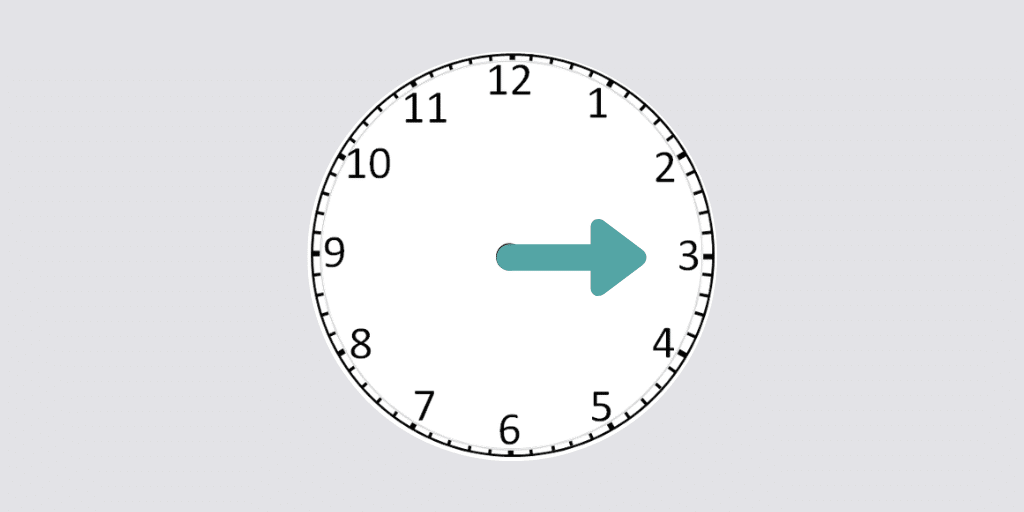
then the minutes hand,
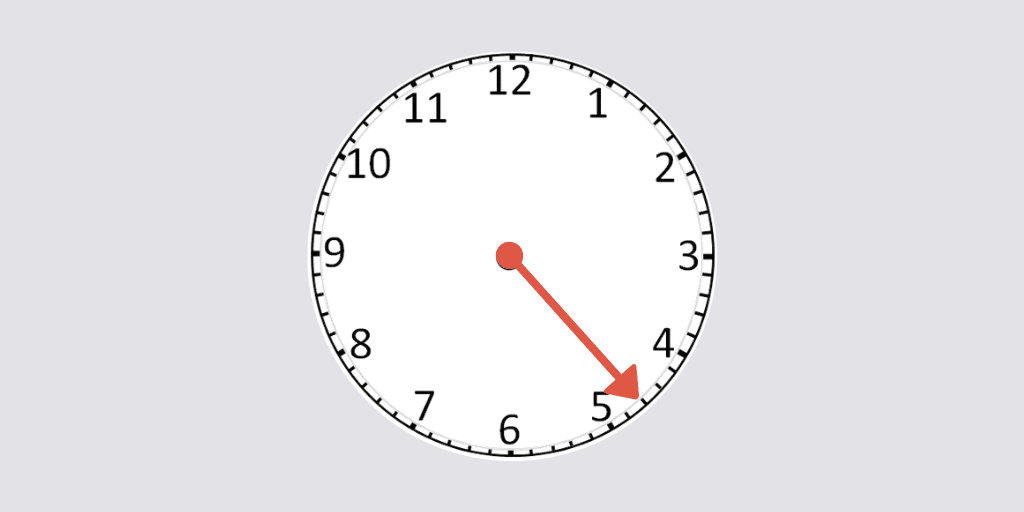
before bringing both hands together onto the same clock.
Home alternatives for learning how to tell the time
Clocks can be made using cardboard.
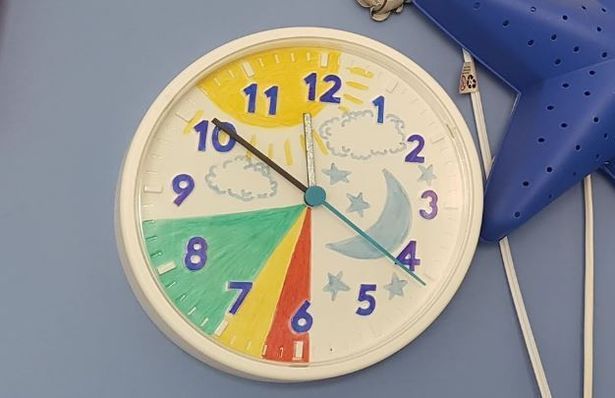
Here’s an ingenious solution to stop your young children becoming organic alarm clocks… That’s right, no waking up the grown-ups until 7am, at the earliest!
Make two separate clocks to represent the hours and the minutes separately before looking at two hands together on one clock.
Counters or lego cubes can be used when making a clock showing the individual minutes.
In this video, we used blue counters to show minutes past and red counters to show minutes to; we look at both the hour and minute hands on separate clocks, before looking at the two hands together on one clock.
Properties of shape
The following is information about how you can help your child to learn about the properties of shape at home.
School resources: 2D and 3D shapes, polydron geometry set
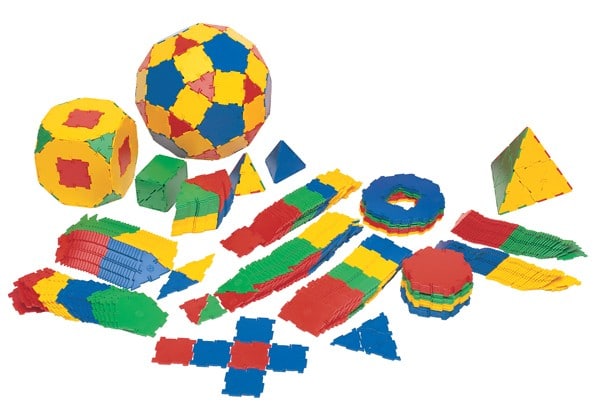
Do you remember these plastic polydron puzzle pieces from your school days?
Children are much more confident identifying properties of shapes when they are able to physically hold them. It is important children understand that the 2D shapes aren’t strictly 2D, but are 2D templates, which can be drawn round to create 2D shapes.
3D shapes the children can hold are much better than 2D drawings of 3D shapes for looking at properties, such as number faces/edges.
Polydron geometry sets are great, enabling children to explore nets and construct 3D shapes.
Home alternatives for learning the properties of shapes
There are many opportunities both at home and when you’re out and about to investigate shapes and their properties.
Children can look around the home and outside – going to the store, on the way to school, eye-spy in the car, wherever – and identify any 2D / 3D shapes they can see. This can generate lots of discussion around their properties.
Children can make 3D shapes using play-doh or lego. Alternatively, they could get creative using marshmallows and toothpicks – or bamboo skewers and masking tape – to construct a range of 3D shapes.
When making 3D shapes from nets, a whole range of nets can be downloaded for free from the internet, which is a great alternative to the plastic polydron geometry sets.
Why you should use concrete resources in your home
If you haven’t tried using concrete resources to support your child at home before, then give it a go!
This is by no means an exhaustive list of topics and resources.
Hopefully, these suggestions have given you some ideas and a starting point, while providing an insight into how useful concrete resources can be in helping children to understand math.
It doesn’t matter what age your child is, concrete manipulatives are a fantastic way to help your child grow their confidence in math, so what are you waiting for?
Read more: What Is Part Whole Model?
Do you have students who need extra support in math?
Give your students more opportunities to consolidate learning and practice skills through personalized math tutoring with their own dedicated online math tutor.
Each student receives differentiated instruction designed to close their individual learning gaps, and scaffolded learning ensures every student learns at the right pace. Lessons are aligned with your state’s standards and assessments, plus you’ll receive regular reports every step of the way.
Personalized one-on-one math tutoring programs are available for:
– 2nd grade tutoring
– 3rd grade tutoring
– 4th grade tutoring
– 5th grade tutoring
– 6th grade tutoring
– 7th grade tutoring
– 8th grade tutoring
Why not learn more about how it works?
Meet Skye, our AI voice tutor. Built on over a decade of tutoring expertise, Skye uses the same proven pedagogy and curriculum as our traditional tutoring to close learning gaps and accelerate progress. Watch a clip of Skye’s AI math tutoring in action.
The content in this article was originally written by assistant headteacher Emma Johnson and has since been revised and adapted for US schools by elementary math teacher Christi Kulesza.
